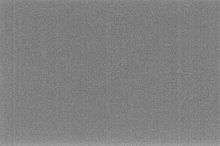Dark-frame subtraction

In digital photography, dark-frame subtraction is a way to minimize image noise for photographs shot with long exposure times, at high ISO sensor sensitivity or at high temperatures. It takes advantage of the fact that a component of image noise, known as fixed-pattern noise, is the same from shot to shot. Noise from the image sensor include defective pixels, which light up more brightly than other pixels, based on the amount of received light. The technique works by taking a picture with the shutter closed and subtracting that electronically from the original photo exhibiting the noise.

A dark frame is an image captured with the sensor in the dark, i.e., with a closed shutter or the lens and viewfinder capped. Such a dark frame is essentially an image of noise produced by the sensor. A dark frame, or an average of several dark frames, can then be subtracted from subsequent images to correct for fixed-pattern noise such as that caused by dark current, but it also works for removing what is called amp glow, portions of the sensor lighting up due to internal heat sources[1]. Dark-frame subtraction has been done for some time in scientific imaging.
Most modern digital cameras have a built-in option called Long Exposure Noise Reduction (LENR) and apply it automatically for exposures beyond a few seconds, but the feature can be disabled. It is important that LENR is performed or dark frames are taken at the same exposure time, ISO sensitivity and ambient temperature as the original photo, because the brightness of fixed pixel noise is dependent on all three parameters. Under these circumstances, a single dark frame can be subtracted from multiple photos taken at these parameters, amounting to a time saving and allowing noise reduction for stacked star trail images, which do not allow interruption.
Visible fixed-pattern noise is often caused by hot pixels – pixel sensors with higher than normal dark current. On long exposure, they can appear as bright pixels. Photosites on the sensor that always appear as brighter pixels are called stuck pixels while sensors that only brighten up after long exposure are called hot pixels.
The dark-frame-subtraction technique is also used in digital photogrammetry, to improve the contrast of satellite and air photograms, and is considered part of "best practice", along with flat-field correction, for astrophotography.[2]
Software that supports dark-frame subtraction
- RawTherapee[3]
- PixelFixer [4]
See also
References
- ↑ http://darkerview.com/CCDProblems/ampglow.php
- ↑ Robert K. Buchheim (2007). The sky is your laboratory: advanced astronomy projects for amateurs. Springer. p. 109. ISBN 978-0-387-71822-4.
- ↑ http://rawpedia.rawtherapee.com/Dark_Frame
- ↑ http://www.pixelfixer.org
External links
- "Dark Frame Subtraction using Adobe Photoshop" by Chris Limone